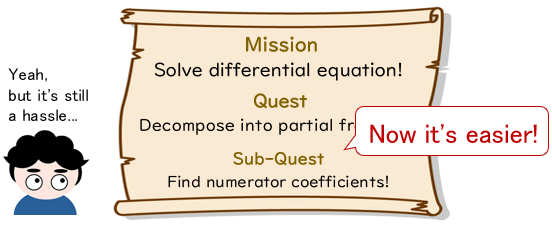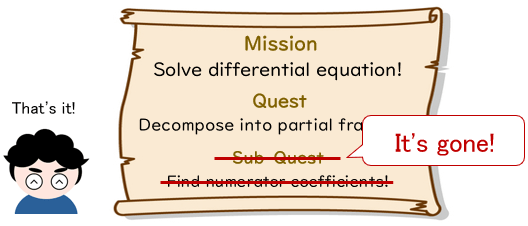Partial fraction decomposition is often needed, particularly when solving differential equations using the Laplace transform or computing integrals.
This page introduces the major methods of partial fraction decomposition: Comparative study of the comparing coefficients method and the Heaviside cover-up method.
Note: For details on how to solve differential equations using the Laplace transform, please see this page:
- There is a rule for decomposed form of partial fractions, so it is helpful to remember it.
- The comparing coefficients method predicts the decomposed form and calculates the solution backward from it.
- The Heaviside cover-up method offers an easier compute process than the comparing coefficients method.
Basics of Partial Fraction Decomposition
What is Partial Fraction Decomposition?
The operation of decomposing a product of fractions into sums (or differences) of fractions is called partial fraction decomposition.
$$\frac{1}{(s+1)(s+2)} = \frac{1}{s+1}\ -\ \frac{1}{s+2}\quad \color{green}{\text{Decompose!}} $$
Note: In this page, the variable is denoted as $s$, assuming it in Laplace transform.
Generally, practical cases consist of a bit more complex denominator and numerator terms, as shown below:
$$\frac{5s^2+9s+12}{(s+1)(s^2+2s+3)} = \frac{4}{s+1} + \frac{s}{s^2+2s+3}$$
Note that each denominator after the decomposition must be in a form that cannot be further factored. If a denominator can form a product, it should be further decomposed.
$$\frac{1}{3s+4} + \ubg{\frac{1}{2 s^2+5s+3}}{\large \text{Finished?}}\ =\ \frac{1}{3s+4} + \ubgd{\frac{1}{(s+1)(2s+3)}}{\large \text{Can be further}}{\large \text{decomposed!}}$$
Decomposed Form
Before moving on to the methods of partial fraction decomposition, let us first learn the form of partial fractions after decomposition. The decomposed terms should be in the following forms:
- Each factor of the denominator is decomposed into individual denominator terms.
$$\frac{N(s)}{(s+1)\color{red}{(s+2)}\color{blue}{(s+3)}} = \frac{A}{s+1}+ \frac{B}{\color{red}{s+2}} + \frac{C}{\color{blue}{s+3}}$$
- The maximum degree of the numerator equates “the degree of the denominator – 1”.
$$\frac{N(s)}{(s+1)(s^2+s+1)} = \frac{A}{s+1}+ \frac{Bs+C}{s^2+s+1}$$
- For exponential power terms, it is decomposed into terms with power less than or equal to the highest power.
$$\frac{N(s)}{\color{red}{(s+1)^3}(s^2+s+1)} = \frac{A}{\color{red}{s+1}} + \frac{B}{\color{red}{(s+1)^2}} + \frac{C}{\color{red}{(s+1)^3}}+ \frac{Ds+E}{s^2+s+1}$$
Note: $A$, $B$, $C$, $D$, and $E$ are real numbers.
The comparing coefficients method and the Heaviside cover-up method calculate the solution backward from these forms. So, the above concept should be kept in mind.
Comparing Coefficients Method
Method
Now, let’s learn the comparing coefficients method.
As an example, consider the partial fraction decomposition of the following fraction:
$$\frac{4s^2+4s-8}{(s+1)(s^2+3s+10)}$$
By the law shown earlier, we can predict the decomposed form as follows:
$$\frac{A}{s+1} + \frac{Bs+C}{s^2+3s+10} = \frac{(A+B)s^2+(3A+B+C)s+(10A+C)}{(s+1)(s^2+3s+10)} $$
To equate the original fraction, comparing the coefficients of each term yields as per the following relationship:
$$\left\{ \begin{array}[l]\ A+B=4\\3A+B+C=4\\10A+C=-8\end{array}\right.$$
All that remains is to solve this and substitute the solution into the original equation to complete the decomposition.
$$\text{Substituting } A=-1, \ B=5, \ \text{and }C=2 \text{ into the original equation,}$$
$$\frac{4s^2+4s-8}{(s+1)(s^2+3s+10)}=-\frac{1}{s+1} + \frac{5s+2}{s^2+3s+10}$$
Advantages and Disadvantages
This method offers simple theory to understand easily. Some of you may have learned this method in high school.
One disadvantage—solving simultaneous equations can be time taking. As simultaneous equation becomes more complex with increasing number of variables, it could consume more time and effort also.
Most of all, it can be tiring to feel like we are being forced to do another problem of solving simultaneous equations, even though all we want to do is to decompose fractions. Actually, even partial fraction decomposition is just a means to an end!

Another drawback is the need to predict the decomposed form first. If we get this wrong, all our subsequent hard work will be lost.
Heaviside cover-up method
Method
The Heaviside cover-up method can alleviate the above drawbacks. Although this method is interpreted in many ways, herein we present a simple one to ease its practical purpose.
Note: The mathematically strict Heaviside cover-up method is not explained here because of complicated formula. If you are interested, please carry out a different search on the topic.
For instance, let’s decompose the following fraction. Similar to the comparing coefficients method, we predict the decomposed form first.
$$\frac{-s+7}{(s+1)(s+5)} = \ubg{\frac{A}{s+1} + \frac{B}{s+5}}{\large \text{Should be like this}}$$
Since we only change the expression of fraction, this is an identity, i.e. an equation that always holds. Let’s take advantage of this property to find $A$ and $B$.
First, multiply both sides by $(s+1)$.
$$\frac{-s+7}{s+5} = A + \frac{B(s+1)}{s+5}$$
Since the above equation is also an identity, it should hold for any value of $s$. Therefore, let $s=-1$.
$$\frac{1+7}{-1+5} = A \quad \text{Therefore,} \ A=2$$
By substituting $s=-1$, the term of $B$ vanished, and $A$ is easily obtained.
Similarly, $B$ can be easily obtained.
$$\begin{align}\color{green}{\text{Original formula}:}\quad & \frac{-s+7}{(s+1)(s+5)} = \frac{A}{s+1} + \frac{B}{s+5}\\[10pt] \color{green}{\text{Multiplying both sides by }(s+5):}\quad & \frac{-s+7}{s+1} = \frac{A(s+5)}{s+1} + B \\[10pt] \color{green}{\text{Substituting }s=-5:}\quad & \frac{5+7}{-5+1}=B\\[10pt] & B=-3\end{align}$$
By using $A$ and $B$ values, the decomposition is completed.
$$ \frac{-s+7}{(s+1)(s+5)} = \frac{2}{s+1} – \frac{3}{s+5}$$
By applying this concept, the coefficients can be directly determined as follows.
$$\ubgd{\frac{-s+7}{(s+1)(s+5)}}{\large \text{Ignore }(s+1)\text{ and set } s=-1 \text{ yields }A}{\large \text{Ignore }(s+5)\text{ and set } s=-5 \text{ yields }B} = \frac{A}{s+1} + \frac{B}{s+5}$$
Simply put, we can solve by substituting $s$ to make the denominators of $A$ and $B$ zero into the original fraction (ignore the divergent part). Interestingly, this operation will eventually equal the above calculation.
If Denominator is Exponential
A minor change is required when the denominator is exponential, for instance:
$$\frac{2s^2+13s-5}{(s+1)(s+5)^2} = \ubg{\frac{A}{s+1} + \frac{B}{s+5} + \frac{C}{(s+5)^2} }{\large \text{Should be like this}}$$
Let’s solve in the same way as before. First, we eliminate the denominator of $A$.
$$\begin{align} \color{green}{\text{Multiplying both sides by }(s+1):}\quad & \frac{2s^2 + 13s -5}{(s+5)^2} = A + \frac{B(s+1)}{s+5}+\frac{C(s+1)}{(s+5)^2} \\[10pt] \color{green}{\text{Substituting }s=-1:}\quad & \frac{2 -13-5}{(-1+5)^2}=A\\[10pt] & A=-1\end{align}$$
Next, let’s eliminate the denominator of $C$.
$$\begin{align} \color{green}{\text{Original formula}:}\quad & \frac{2s^2+13s-5}{(s+1)(s+5)^2} = \frac{A}{s+1} + \frac{B}{s+5} + \frac{C}{(s+5)^2} \\[10pt]\color{green}{\text{Multiplying both sides by }(s+5)^2:}\quad & \frac{2s^2 + 13s -5}{s+1} = \frac{(s+5)^2A}{s+1} + (s+5)B+C \\[10pt]\color{green}{\text{Substituting }s=-5:}\quad & \frac{50 -65-5}{-5+1}=C\\[10pt] & C=5\end{align}$$
Finally, we eliminate the denominator of $B$.
$$\begin{align} \color{green}{\text{Original formula}:}\quad & \frac{2s^2+13s-5}{(s+1)(s+5)^2} = \frac{A}{s+1} + \frac{B}{s+5} + \frac{C}{(s+5)^2} \\[10pt]\color{green}{\text{Multiplying both sides by }(s+5):}\quad & \frac{2s^2 + 13s -5}{(s+1)(s+5)} = \frac{(s+5)A}{s+1} + B+ \frac{C}{s+5}\end{align}$$
Pay attention: if $s=−5$ is used to eliminate the term of $A$, the term of $C$ would diverge, Problem!
In such a case, instead of multiplying both sides by $(s+5)$, we can multiply $(s+5)^2$ and differentiate both sides.
$$\begin{align} \color{green}{\text{Original formula}:}\quad & \frac{2s^2+13s-5}{(s+1)(s+5)^2} = \frac{A}{s+1} + \frac{B}{s+5} + \frac{C}{(s+5)^2} \\[10pt]\color{green}{\text{Multiplying by }(s+5)^2:}\quad & \frac{2s^2 + 13s -5}{s+1} = \frac{(s+5)^2A}{s+1} + (s+5)B+C \\[10pt]\color{green}{\text{Differentiating both sides}:}\quad & \frac{(4s+13)(s+1)-(2s^2+13s-5)}{(s+1)^2}=\frac{2(s+5)(s+1)-(s+5)^2}{(s+1)^2}A + B\\[10pt] \color{green}{\text{Substituting }s=-5:}\quad& \frac{-7\cdot (-4) – (50-65-5)}{16}=B \\[10pt] & B=3\end{align}$$
Remember, always multiply both sides by the highest degree, and then differentiate as needed.
All that remains is to substitute the respective solutions.
$$\frac{2s^2+13s-5}{(s+1)(s+5)^2} = -\frac{1}{s+1} + \frac{3}{s+5} + \frac{5}{(s+5)^2}$$
Advantages and Disadvantages
Biggest advantage of the Heaviside cover-up method—coefficients can be obtained without directly solving the simultaneous equations. As shown above, the coefficients are evaluated by substituting a convenient $s$.
One major drawback—the degree of the denominator factors must be 1.
For example, consider the quadratic factor as follows:
$$\frac{1}{(s+1)\ubgd{(s^2+4s+6)}{\large \text{Cannot be decomposed}}{\large \text{as }(s+a)(s+b)}}$$
This cannot be factorized any further. Therefore, no real number of $s$ can make this part 0, so the advantage is no longer applicable.
Note: It can be solved by substituting a complex solution for $s$, but it is generally easier to use the comparing coefficients method.
Another drawback—it still feels like to carry out another problem of finding coefficients, even though it is time-saving than comparing coefficients method.

In addition, it is necessary to predict the decomposed form first as with the comparing coefficients method.
If the advantages outweigh these disadvantages, the Heaviside cover-up method can be very useful.
Incidentally, please refer to this page to explore new approach for partial fraction decomposition that eliminates all the mentioned shortcomings.

- There is a rule for decomposed form of partial fractions, so it is helpful to remember it.
- The comparing coefficients method predicts the decomposed form and calculates the solution backward from it.
- The Heaviside cover-up method offers an easier compute process than the comparing coefficients method.




Comments